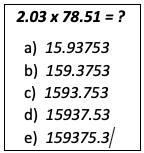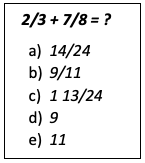Estimation – What Good Is It?
by Donna Curry
That’s a good question: what good is estimation? After all, aren’t tests are just looking for the right answer? Let’s explore this idea, but first try this quick test-like question:

Were you able to immediately find the answer because you knew that 2 x 80 is 160? Or did you get out your calculator to figure out the answer? If the latter, you might be one of many who could use some help with number sense – something that estimation skills help build.
Most of our students (and too many of us) have been taught to immediately pick up our pencils and DO something – anything – when we have a math problem to solve. We rarely first ask, “Should the answer be larger or smaller than the numbers that I’m working with?” or “Is this a situation where something is growing?” Too often students ‘solve’ the problem then expect us to tell them whether the answer is correct or not. And, we often wind up asking the student, “Does this answer make sense?” I think we wouldn’t have to ask them if instead we taught them to reason and then do some estimation to determine what might be a logical answer.
Let’s look at some examples of how reasoning and estimation could really help students using this statement as a starting point:
Johnetta bought a $34.99 skirt that was half price. The sales tax was 5%.
There’s a variety of questions that could be asked about this statement. Some common ones could be: How much money did she save? What was the amount of tax? What’s the total price she paid including sales tax? If a student can reason and use estimation, it doesn’t matter what the question is. She could quickly determine a ballpark answer to a variety of questions, such as the following:



In the first situation, a student who can reason and estimate could determine that half of $35 is $17.50. If she knows 10% percent tax on $17.50 is $1.75, she would also be able to figure out that half of that (5% tax) is less than a dollar. So, $17.50 plus a little less than a dollar in tax will be a little under $18.50.
In the second situation, a student could use similar reasoning: an estimate of 10% tax on $35 is $3.50. So, 5% tax would be about $1.75.
In the third situation, it is fairly obvious what the answer should be . . . but ONLY if we can reason. We don’t even have to bother doing any calculations. Clearly the answer has to be more than $35, so there is only one possibility. No calculations needed to this typical test-like question.
And, what about the ubiquitous fraction problems? How does estimation fit?

Our students can never remember to find the common denominator so 9/11 makes sense if they’ve been taught a procedure. They might not remember exactly what procedure to use when, but they know they need to follow a procedure. If instead, they are taught how to reason, they can use estimation and eliminate the answer 9/11 immediately. 2/3 is more than half. 7/8 is close to 1. So the answer has to be at least 1 but less than 2.
But, if they don’t work out the problem and instead use estimation, how do we know they understand? In estimating, it is clear that the students understand about the relative size of the fractions compared to benchmark fractions. On the other hand, what do students really know when they follow a procedure that they have been told to memorize?

Rather than needing to do a lot of calculating, if students know that π is about 3, they can estimate the answer. Of course, this assumes that they know the difference between area and circumference. Perhaps they would if they could, in their heads, simplify π and focus on the different formulae instead. While some of you might be saying that they need to be more accurate, let’s talk about how accurate is accurate enough. After all, 3.14 is only an estimate. So is 3.14159. And so is 3.14159265359.
When we’re talking about estimation, we’re not necessarily talking about the traditional rule (which we CAN and should break when needed) that says we round up or down, based on whether the number next to the place we want to round to is 5 or more. Estimation can be more flexible than that. For example, a person might choose to round $4.34 up to $5 (rather than round down to $4) to make sure he has enough cash when he gets to the checkout counter. Or perhaps we want to round one number to make it more compatible with another number; for example, to estimate the size of the fraction 18/35, one might round the 35 to 36 because mentally it’s easier to compare the relationship of 18 to 36.
Are you thinking, “Wait, my students can’t reason like that!” Well, how about we make that our responsibility – to teach them to reason and estimate. We understand the pressure to “teach to the test” but think of teaching reasoning and estimation skills as a worthy short- and long-term investment. Students with the ability to reason and estimate have an advantage over those who are just taught to memorize, whether on a test or in real life.
===========================================================================

Donna Curry is the Director of the SABES Mathematics and Adult Numeracy Curriculum & Instruction PD Center, a project managed by the Adult Numeracy Center at TERC. She has trained teachers nationally, taught and administered ABE classes, and developed adult education curricula and resources for over 30 years.
